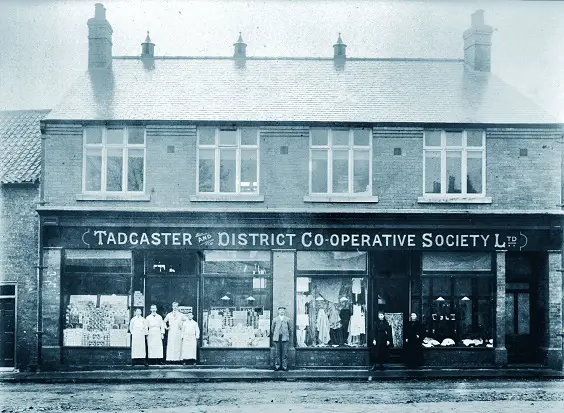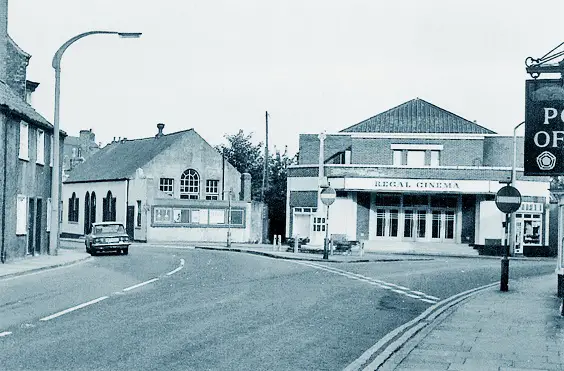Historic Tadcaster: A Pictorial History Tour of the North Yorkshire Town

By Paul Chrystal
Think of Tadcaster and you think of breweries and beer. The town has been brewing since 1341, but it really came into its own when domestic production was industrialised by the Smith family and others at the end of the nineteenth century, leaving a legacy in the shape of Samuel Smith and John Smith, complemented today by a third, Molson Coors Brewing Co.
Harry Speight, writing soon after Jackson, attests that beer was in the air: ‘In our walks about Tadcaster certain odoriferous breezes make us conscious of the presence of these famous breweries … Tadcaster air is surcharged with the extract of malt.’ The good brewing water from springs or popple wells around the River Wharfe inspired the development of beer production here; add to that the importance of Tadcaster as a staging post on the London to Edinburgh road and, along with the three breweries, you begin to understand the plethora of inns and taverns in the town.
 It was vital that the town provided accommodation and refreshment for both man and horse. But it isn’t all beer and skittles here, and spring water isn’t the only natural resource that makes Tadcaster famous: Tadcaster magnesian limestone has long been highly sought after and many iconic English buildings, including York Minster no less, are built with it. The Romans knew all about this stone and called their settlement here Calcaria.
It was vital that the town provided accommodation and refreshment for both man and horse. But it isn’t all beer and skittles here, and spring water isn’t the only natural resource that makes Tadcaster famous: Tadcaster magnesian limestone has long been highly sought after and many iconic English buildings, including York Minster no less, are built with it. The Romans knew all about this stone and called their settlement here Calcaria.
“Community”
The River Wharfe and its bridges are, of course, central to the town and account for its very existence and development. There are many fine buildings around Tadcaster that survive from as far back as the fifteenth century: the oldest, the Ark, has been serving the community for many years and still does today as local council offices; the striking viaduct, ever redundant as a means of crossing the Wharfe in a passenger train, now forms part of an enjoyable town walk; and from St Mary’s Church a beautiful William Morris window shines out.
The villages around Tadcaster are especially important for their military history. Towton was the site of England’s biggest and bloodiest battle during the Wars of the Roses, while 600 years later Thorp Arch turned out pieces of ammunition by the million during the Second World War. The peaceful and cerebral Boston Spa is now the home of the northern British Library, and Bramham Park hosts the Bramham Horse Trials and Leeds Festival each year.
Below is a brief, pictorial history of Tadcaster and the surrounding area.
TADCASTER BEACH, 1933
A popular summer’s day out for both locals and day trippers from the towns of the West Riding looking for somewhere nearer and cheaper than Scarborough or Filey. Tadcaster was founded by the Romans, who called it Calcaria, from the Latin word for lime, reflecting the limestone deposits that have been quarried there for centuries. Many famous buildings, including York Minster, are built from Tadcaster limestone, the stone being conveyed by boat to York (‘per navem a Tadcastre usque Ebor ’). According to the fabric rolls in the Minster, it was still going on in 1403: ‘caryying unius shypfull petrarum per aquam’ – 0/10 for the Latin.
HUDSON’S FOLLY AND THE WEIR
A quarter of a mile above the Wharfe Bridge, an imposing viaduct of eleven arches spans the River Wharfe. This was built as part of the projected Leeds–York railway promoted by the industrialist George Hudson, ‘Railway King’, for the North Midland Railway. The go ahead for the line was given in 1846: it was to run from Copmanthorpe to Cross Gates, meeting the Church Fenton to Harrogate line between Tadcaster and Stutton.
Unfortunately, Hudson’s financial problems in 1849 and the marshy land under the tracks meant that the line was never completed and the viaduct was only ever used by trains taking coal to Ingleby Mills from 1882 to 1955. The need for the line evaporated completely with the opening of the Micklethorpe to Church Fenton line in 1869. A Grade II-listed building, it is now the integral feature of the Viaduct Walk, which starts at the Wetherby Road. It was bought by the town council from British Rail for £100 in 1980.
SAM SMITH’S OLD BREWERY OFFICES
The Old Brewery at Tadcaster on the left here was established in 1758. It is the smallest of the three Tadcaster breweries, independently run, and the oldest brewery in Yorkshire. The original well was sunk in 1758 and is still used today; the water for the beers is drawn from 85 feet underground. Samuel Smith still ferments ale and stout in traditional Yorkshire stone ‘squares’ – roofed fermenting vessels made of solid blocks of slate. The strain of yeast used today has been used at the Old Brewery continuously since the beginning of the twentieth century; it is one of the oldest unchanged strains in the country. The brewery cooper makes and repairs all the wooden casks used for the brewery’s Old Brewery Bitter.
SNOBS’ BREWERY
This brewery was built on land bought for £484 from George Hudson’s ill-fated North East Railway in 1882, at the end of Wetherby Road and bound by the Harrogate line and the branch line to the viaduct. Tower Brewery earned its nickname from the aloofness of the original owners: affluent young men from fashionable York who rarely came to Tadcaster and remained somewhat mysterious to local townsfolk and even the workers. The owners were in fact Hotham & Co. – brewers of York in George Street since 1716 who also owned ninety of the 284 pubs in the city around 1870.
In 1875 Hotham’s sold up for £36,000 to a consortium of York and London businessmen, who promptly bought Yates’s brewery in York for £12,000 including a further twelve York pubs. The new owners were in their late twenties, old Etonians, and shared a passion for horse racing, which they were able to indulge at the Knavesmire. The company changed its name to the Tadcaster Tower Brewery Co. in November 1882. The old picture shows brewery drays setting off for a delivery and North Eastern steam engines in the yard on the lines that served the brewery.
THE OLD FALCON
The Old Falcon was part of the Ark building in Kirkgate and was run from 1822 for over 100 years by the Liversedge family. In 1844, Thomas Liversedge was also a lime burner. The pub was the last free house in Tadcaster until John Smith bought it in 1942, with it closing soon after the Second World War.
TADCASTER AND DISTRICT CO-OPERATIVE SOCIETY
The Tadcaster Co-op pre-1910, before the bakery and butchery departments moved into two houses to the left of the shop. This picture shows three proud members of staff from the grocery department. Pelaw Polishes seem to have a monopoly on the window advertising, even over the Ideal evaporated milk and women’s fashion displays. The Co-op closed in 1984.
WILSON’S THE COBBLER’S, YORK ROAD, 1928
An intriguing shot of this cobbler’s and a good example of a business being run from home. Tadcaster was one of England’s first post towns – where horses were changed in a kind of relay between major towns, in this case the road between London and Edinburgh via York. In the mid-1600s the postmaster was a Mr Taylor, landlord of the Swanne Inn. The journey to London took four days and cost 40s. In 1880 fifty stagecoaches passed through Tadcaster with thirty or so stopping to change horses.
TADCASTER STATION, 1915
Tadcaster station was on the line between Church Fenton and Harrogate, which opened in 1847 and was owned by the York & North Midland Railway. It was designed by G. T. Andrews, the architect responsible for the elegant de Grey Rooms and the Bar Convent façade in York. The goods yards and station occupied over 8 acres between Station Road and Leeds Road. In 1854 it was staffed by a stationmaster, eight labourers and two porters. In 1911, 30,000 tickets were sold and there were nine trains in each direction by 1932. During the war the line served the munitions factory at Thorp Arch. The station closed to passenger traffic in 1964 and was demolished (despite its designation as a listed building) later to make room for the station industrial estate.
BRIDGE STREET FLOODS, 1950
Bridge Street once flooded quite frequently. Here we can see improvised means of transport sailing down the street. Celia Fiennes, in 1697, describes Tadcaster and her flooding in the late seventeenth century: ‘This stands on a very large River Called the Whart. Just before you Come to ye town there is some of ye water wch on Great raines are not to be pass’d – it was very deep when I went through.’
REGAL CINEMA AND THE SUNDAY SCHOOL
The Regal opened in 1938 in Westgate and replaced the Cosy Cinema in the High Street. There was room for 670 cinemagoers but queues extending down Westgate into Kirkgate were still a common sight. The premiere was Maytime starring Nelson Eddy and Jeanette Macdonald. Seats cost 1s 3d, and 2s 6d; the children’s matinee on Saturday mornings cost 7d. The Regal closed in 1976 with a showing of Where Eagles Dare. It was demolished in 1986.
MARKET PLACE
Taken in 1908, this clearly shows C. Woodson’s café and sweetshop on the left with the big Hovis and refreshments signs, then G. H. Moon’s grocery; Askey’s stationers, library and printers is directly opposite (later Grimston’s). George Tindall’s plumbers is on the right to the left of the shop with the awning and Barber’s House Furnishers next to that in the building once occupied by the Railway Hotel. George Tindall was nothing if not versatile, offering his services as glazier, gas, water and steam fitter, bell hanger, plumber, sanitary, and electric light engineer. Barber’s later became Barber & Turner’s – a toy as well as a furniture shop. This is where Mr Rodgers of the Tower Brewery bought queues of boys and girls a present of their choice on Christmas Eve.
ULLESKELF RAILWAY DISASTERS, 26 MAY 1906 AND 8 DECEMBER 1981
In 1839, 4 miles from Tadcaster, the station opened on the York & North Midland Railway. In 1981 the 13.50 p.m. York to Liverpool train took leave of the track at 70 miles per hour and careered down the embankment. Twenty-two passengers required hospital treatment. An incident on 4 October 2010 involved a ‘bovine incursion’ (cows on the line to you and me) when two cows were killed. Ulleskelf, derived from the Scandinavian, refers to Ulfr’s shelf of land. In Domesday, Ulleskelf was known as Oleschel and was part of the Archbishop of York’s land. In 1066 at the Battle of Fulford, Earl Edwin of Mercia moored his boats at Ulleskelf to prevent the invading army reaching York. An episode of A Touch of Frost was filmed in the village in 2008.
‘Tadcaster History Tour’ by Paul Chrystal is published by Amberley Publishing, £6.99, ISBN: 9781445677309






















My late mother’s family name was Iredale. Her father was Alfred Iredale who had a tailoring business in Tadcaster with his brother William. Alfred was also a Methodist Local Preacher from 1931 to 1954. I am a local preacher myself and have some of his sermons and his preachers service register.
Alfred died in 1954 so I never got to meet him. My mother moved to the Midlands shortly afterwards to live with her sister who had moved here after her marriage.
Alfred served in the Great War with his brothers. Alfred was in the RFC as an observer, William served as a Sapper I believe. Eddie was killed at Thiepval. I was fortunate enough to visit his grave a couple of years back. Charles died of Spanish flu in Greece. There was another brother, Thomas Wray who was much younger and served in the RAF in WW2.
I am interested in learning more about the history of the Iredales (Great Grandad Charlie was a postman I believe) and also the Nettletons (my grandmother). Any information would be greatly appreciated.
Samuel Swaine died 1889 and called Samuel Smiths then any maps of Brewery Lane it was on that street
It was called Samuel Swaines brewery prior to being Samuel Smiths if you look it up Samuel Swaine was a brewer and also distillers and hops merchants in national archives
The Coop was on the side of Chapel St where the Social Club, former British Legion, now stands.
Where was the old Co-op.
Anyone know?
I’m not aware of such a pub.
The pubs I remember from that period in time were:
The Leeds Arms, York Road
The Royal Oak, Wighill Lane
The Bay Horse, Commercial Street
Coach & Horses, Commercial Street
Brittania Inn, Commercial Street
The Black Swan, High Street
The one where the shop for Yorkshire Cancer Research is/as The Golden lion ?
The Londesborough Hotel – now The Angel & White Horse
The Fleece, Kirkgate
The Howden Arms
The Fox & Hounds
The Jackdaw, Sutton Road
The Falcon, Chapel Street
HAS ANYONE ANY INFO ON BREWERY LANE TADCASTER, MAPS, PICS ETC BOOKS
Was there a Pub with accommodation in Tadcaster in the 70s by the name of the Union Jack or Union Flag???